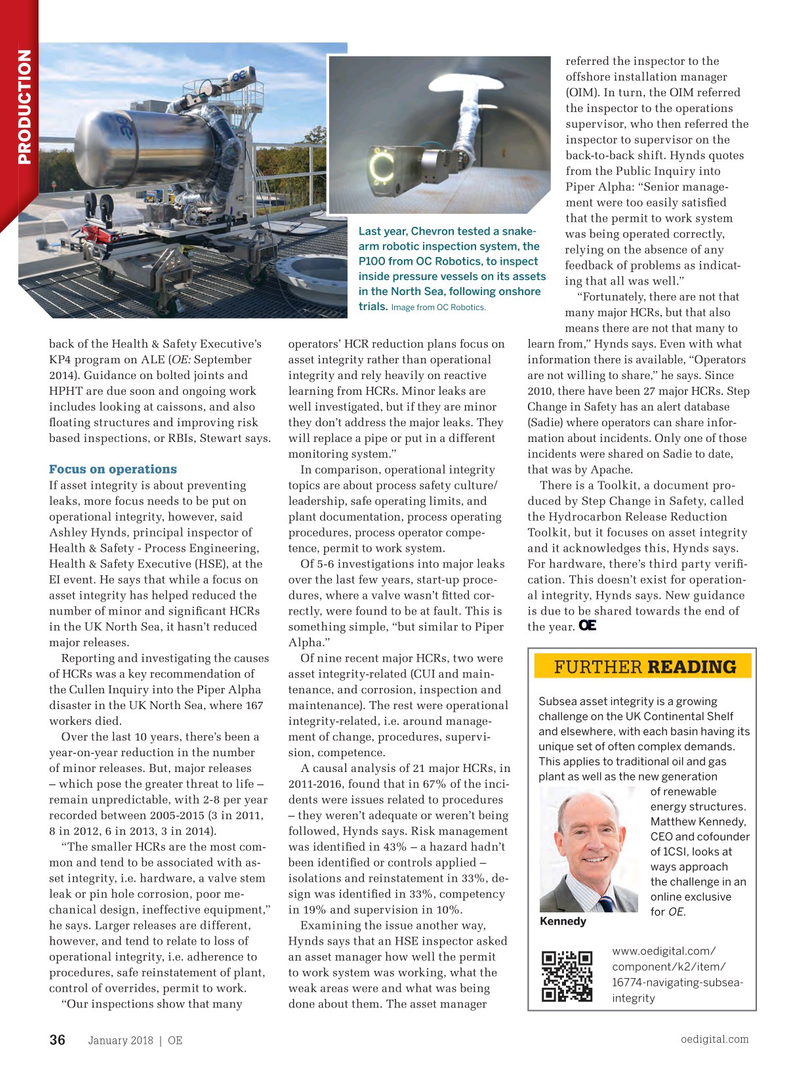
Page 34: of Offshore Engineer Magazine (Jan/Feb 2018)
Read this page in Pdf, Flash or Html5 edition of Jan/Feb 2018 Offshore Engineer Magazine
referred the inspector to the offshore installation manager (OIM). In turn, the OIM referred the inspector to the operations supervisor, who then referred the inspector to supervisor on the back-to-back shift. Hynds quotes
PRODUCTION from the Public Inquiry into
Piper Alpha: “Senior manage- ment were too easily satis? ed that the permit to work system
Last year, Chevron tested a snake- was being operated correctly, arm robotic inspection system, the relying on the absence of any
P100 from OC Robotics, to inspect feedback of problems as indicat- inside pressure vessels on its assets ing that all was well.” in the North Sea, following onshore “Fortunately, there are not that trials. Image from OC Robotics.
many major HCRs, but that also means there are not that many to back of the Health & Safety Executive’s operators’ HCR reduction plans focus on learn from,” Hynds says. Even with what
KP4 program on ALE (OE: September asset integrity rather than operational information there is available, “Operators 2014). Guidance on bolted joints and integrity and rely heavily on reactive are not willing to share,” he says. Since
HPHT are due soon and ongoing work learning from HCRs. Minor leaks are 2010, there have been 27 major HCRs. Step includes looking at caissons, and also well investigated, but if they are minor
Change in Safety has an alert database ? oating structures and improving risk they don’t address the major leaks. They (Sadie) where operators can share infor- based inspections, or RBIs, Stewart says. will replace a pipe or put in a different mation about incidents. Only one of those incidents were shared on Sadie to date, monitoring system.”
Focus on operations that was by Apache.
In comparison, operational integrity
If asset integrity is about preventing topics are about process safety culture/ There is a Toolkit, a document pro- leaks, more focus needs to be put on leadership, safe operating limits, and duced by Step Change in Safety, called operational integrity, however, said plant documentation, process operating the Hydrocarbon Release Reduction
Ashley Hynds, principal inspector of procedures, process operator compe- Toolkit, but it focuses on asset integrity
Health & Safety - Process Engineering, tence, permit to work system. and it acknowledges this, Hynds says.
Health & Safety Executive (HSE), at the Of 5-6 investigations into major leaks For hardware, there’s third party veri? -
EI event. He says that while a focus on over the last few years, start-up proce- cation. This doesn’t exist for operation- asset integrity has helped reduced the dures, where a valve wasn’t ? tted cor- al integrity, Hynds says. New guidance number of minor and signi? cant HCRs rectly, were found to be at fault. This is is due to be shared towards the end of in the UK North Sea, it hasn’t reduced something simple, “but similar to Piper the year. major releases. Alpha.”
Reporting and investigating the causes Of nine recent major HCRs, two were
FURTHER READING of HCRs was a key recommendation of asset integrity-related (CUI and main- the Cullen Inquiry into the Piper Alpha tenance, and corrosion, inspection and
Subsea asset integrity is a growing disaster in the UK North Sea, where 167 maintenance). The rest were operational challenge on the UK Continental Shelf workers died. integrity-related, i.e. around manage- and elsewhere, with each basin having its
Over the last 10 years, there’s been a ment of change, procedures, supervi- unique set of often complex demands. year-on-year reduction in the number sion, competence.
This applies to traditional oil and gas of minor releases. But, major releases A causal analysis of 21 major HCRs, in plant as well as the new generation – which pose the greater threat to life – 2011-2016, found that in 67% of the inci- of renewable remain unpredictable, with 2-8 per year dents were issues related to procedures energy structures. recorded between 2005-2015 (3 in 2011, – they weren’t adequate or weren’t being
Matthew Kennedy, 8 in 2012, 6 in 2013, 3 in 2014). followed, Hynds says. Risk management
CEO and cofounder “The smaller HCRs are the most com- was identi? ed in 43% – a hazard hadn’t of 1CSI, looks at mon and tend to be associated with as- been identi? ed or controls applied – ways approach set integrity, i.e. hardware, a valve stem isolations and reinstatement in 33%, de- the challenge in an leak or pin hole corrosion, poor me- sign was identi? ed in 33%, competency online exclusive chanical design, ineffective equipment,” in 19% and supervision in 10%.
OE for .
Kennedy he says. Larger releases are different, Examining the issue another way, however, and tend to relate to loss of Hynds says that an HSE inspector asked www.oedigital.com/ operational integrity, i.e. adherence to an asset manager how well the permit component/k2/item/ procedures, safe reinstatement of plant, to work system was working, what the 16774-navigating-subsea- control of overrides, permit to work. weak areas were and what was being integrity “Our inspections show that many done about them. The asset manager oedigital.com
January 2018 | OE 36 034_OE0118_Prod1_aset integ.indd 36 12/27/17 7:18 PM

 33
33

 35
35